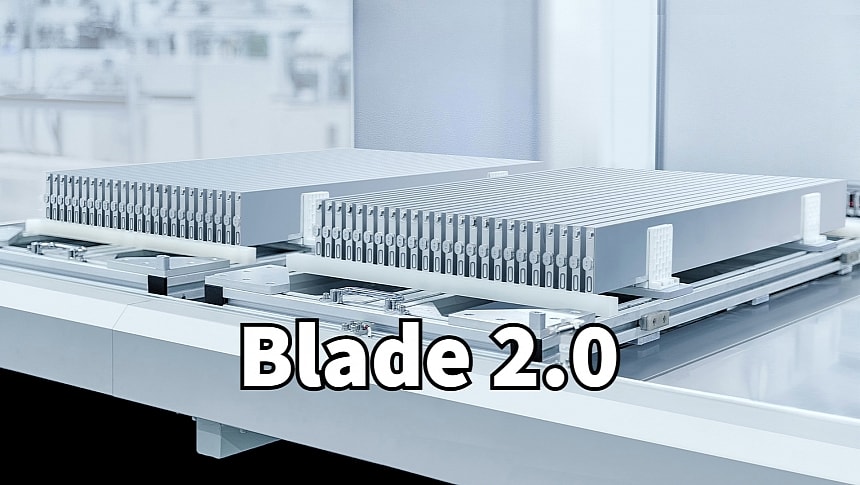The world's biggest battery manufacturers, BYD and CATL, will soon ship lithium-iron-phosphate (LFP) battery cells that can be charged from zero to 100% in ten minutes. CATL will ship 6C-capable Qilin 2.0 batteries by the end of the year, while BYD will have its Blade 2.0 batteries with similar charging performance in the second half of 2024.
Having started as inexpensive cells for entry-level electric vehicles, LFP battery cells are poised to dominate the EV industry as the performance choice. The LFP chemistry has been constantly improved, with the best LFP cells almost on par with NMC cells regarding energy density. However, they appear to gain an edge in fast charging, with record 6C rates that would allow them to fully charge in 10 minutes.
BYD and CATL, currently the world's biggest battery manufacturers, are working on ultra-fast charging battery cells with 6C capability. BYD will launch its Blade 2.0 battery in the second half of the year, according to a report from China. CATL also plans to launch the second generation of its Qilin battery with a similar performance by the end of 2024. Both use lithium-iron-phosphate (LFP) chemistry, which has gained wide acceptance among EV makers.
Currently, the best LFP cells produced by CATL, called Shenxing, support 5C charging, which means they can theoretically be fully charged five times in an hour or about 12 minutes. The first electric car that uses the Shenxing battery is Zeekr 001, which only takes 11.5 minutes to charge from 10% to 80%. The other leading battery manufacturer, BYD, is less advanced in this regard, with its Blade battery charging at 4C. It needs about 15 minutes to fully charge, which is still a respectable achievement.
CATL only launched its 5C-capable Shenxing battery in February, which explains why the Chinese batter maker targets the launch of its 6C battery toward the end of 2024. However, CATL also announced the Shenxing Plus LFP battery in April, with an improved energy density of 205 Wh/kg. This would allow a reference EV to travel 1,000 km (620 miles) on a charge without increasing the battery size or weight. However, the Shenxing Plus battery only charges at 4C.
BYD appears to be a little behind CATL, with its best Blade batteries only charging at 4C. However, Chinese media reports that the company is following a different strategy. BYD traditionally makes product announcements only after ensuring that its technology is production-ready. This gives more credibility to the reports that BYD will have its 6C batteries ready in the coming months.
Even though we'll soon have batteries capable of ultra-high charging rates, it doesn't mean much if the infrastructure limits charging speeds. A 6C battery with a capacity of 100 kWh would require chargers capable of dispensing over 650 kW, including losses. In February, Huawei announced its most powerful DC fast charger, which can deliver up to 600 kW of power. However, most DC fast chargers available to Chinese EV owners are rated at 120 kW.
BYD and CATL, currently the world's biggest battery manufacturers, are working on ultra-fast charging battery cells with 6C capability. BYD will launch its Blade 2.0 battery in the second half of the year, according to a report from China. CATL also plans to launch the second generation of its Qilin battery with a similar performance by the end of 2024. Both use lithium-iron-phosphate (LFP) chemistry, which has gained wide acceptance among EV makers.
Currently, the best LFP cells produced by CATL, called Shenxing, support 5C charging, which means they can theoretically be fully charged five times in an hour or about 12 minutes. The first electric car that uses the Shenxing battery is Zeekr 001, which only takes 11.5 minutes to charge from 10% to 80%. The other leading battery manufacturer, BYD, is less advanced in this regard, with its Blade battery charging at 4C. It needs about 15 minutes to fully charge, which is still a respectable achievement.
CATL only launched its 5C-capable Shenxing battery in February, which explains why the Chinese batter maker targets the launch of its 6C battery toward the end of 2024. However, CATL also announced the Shenxing Plus LFP battery in April, with an improved energy density of 205 Wh/kg. This would allow a reference EV to travel 1,000 km (620 miles) on a charge without increasing the battery size or weight. However, the Shenxing Plus battery only charges at 4C.
BYD appears to be a little behind CATL, with its best Blade batteries only charging at 4C. However, Chinese media reports that the company is following a different strategy. BYD traditionally makes product announcements only after ensuring that its technology is production-ready. This gives more credibility to the reports that BYD will have its 6C batteries ready in the coming months.
Even though we'll soon have batteries capable of ultra-high charging rates, it doesn't mean much if the infrastructure limits charging speeds. A 6C battery with a capacity of 100 kWh would require chargers capable of dispensing over 650 kW, including losses. In February, Huawei announced its most powerful DC fast charger, which can deliver up to 600 kW of power. However, most DC fast chargers available to Chinese EV owners are rated at 120 kW.









